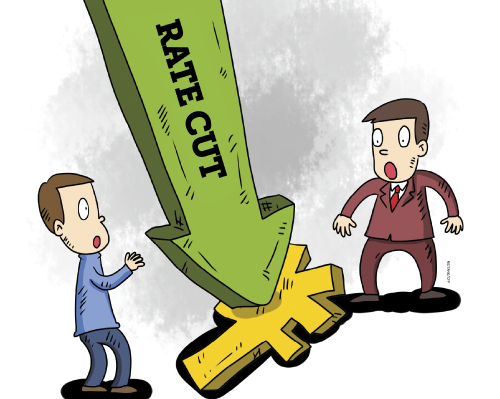|
 |
|
(MEITANG/CFP) |
Three months after the previous rate cut, the People's Bank of China (PBC), the country's central bank, slashed benchmark interest rates by 0.25 percentage points on March 1, bringing the one-year benchmark lending rate to 5.35 percent and one-year benchmark deposit rate to 2.5 percent. The PBC also lifted the deposit rate ceiling from 1.2 times the benchmark rate to 1.3 times to further promote interest rate liberalization.
The PBC said in a statement that the focus of the rate cut this time is allowing benchmark rates to continue to guide market rates, further lower financing costs and provide a neutral monetary environment for economic restructuring, transformation and upgrading.
On February 5, the PBC cut the reserve requirement ratio (RRR) for all financial institutions by 0.5 percentage points, and on November 22, 2014, the central bank cut the benchmark rate for deposits by 0.25 percentage points to 2.75 percent, and the one-year lending rate by 0.4 percentage points to 5.6 percent.
"Affected by accelerated economic restructuring and the remarkable decline of bulk commodities in the international market, the growth rate of the consumer price index (CPI) has fallen, and the producer price index has continued to decline in recent months, pushing up the real interest rate," said the PBC in a statement released alongside the rate cut. "Currently consumer price growth is at a record low, providing space for the interest rate adjustment."
From the market's perspective, the rate cut has been a long-time coming, because it is an inevitable choice when the economic growth is slowing down and deflation is emerging. Liu Dongliang, a senior analyst with the Financial Market Department of China Merchants Bank, said that, when the economic growth further slows down, the central bank must accelerate easing the monetary policy. If the rate cut comes too late, the economy is likely to stall. Moreover, reducing the interest rate can better stimulate credit growth than an RRR cut will do.
When cutting the interest rates, the central bank has also lifted the deposit rate ceiling from 1.2 times the benchmark rate to 1.3 times. Right after the PBC's announcement, Evergrowing Bank, one of the 12 national joint-stock commercial banks, decided to raise its deposit interest rates to 130 percent of the benchmark interest rate of the central bank.
Lou Lili, General Manager of the Department of Strategy and Innovation of Evergrowing Bank Co. Ltd., said the central bank is accelerating interest rate liberalization, so commercial banks must respond actively.
Yang Chi, head of the Strategy Office of Huaxia Bank's Department of Development Studies, told Economic Information Daily that the trend of differential pricing for deposits will be more prominent, and more commercial banks will not be raising their interest rates to the ceiling; rather, they will adopt a flexible pricing strategy considering their own borrowing costs and client structures.
More cuts to follow
The PBC said in the news release that it will focus on keeping interest rates in line with trends in economic growth, consumer prices and employment. However, this does not mean the prudent monetary stance will be changed.
The central bank has stressed that it will maintain the continuity and stability of policies and continue to implement a prudent monetary policy. It will use diversified monetary policy tools and make appropriate preset or fine adjustments at a proper time so as to provide a neutral monetary environment for economic restructuring, transformation and upgrading. It will also promote sustainable economic growth.
| 